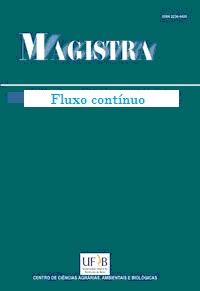Biorational agriculture: herbicidal activity of sorghum extract in control of Cyperus rotundus L.
Resumo
The present estudy aimed to identify the herbicidal effect of sorghum extract in control of Cyperus rotundus L. The work was carried out in greenhouse covered with transparent plastic and shade cloth in the sides with 50% light interception. The C. rotundus L. seedlings with 10 days after emergence were transplanted from the field to the 10 liters pots with a mix of soil, sand and manure in a 3:1:1 propotion respectively. The experiment followed the completely randomized design in 4x5 factorial array with four types of sorghum extract: root extraction in alcohol, leaf extraction in alcohol, root extraction in water and leaf extraction in water and five concentrations (0%, 20%, 40%, 80% e 100%). Four applications of five ml per plant were made in 10 days intervals, initiated when the plants were 30 days old. The sorghum leaf extract shows a herbicidal effect in C. rotundus by interfering in plant growth. The extracts diluted in water and alcohol showed efficency in C. rotundus growth reduction, as long as the allelochemical it’s extracted from the leaf, by the fact that the extraction of root showed low herbicidal effect in C. rotundus plants. The sorghum leaves showed great allelochemical production with herbicidal action and represents a promising biorational alternative in weeds control, however, futher studies with variations in concentrations and large number of weed species it’s necessary for a broad utilization.
Downloads
Referências
Alvares, C. A., Stape, J. L., Sentelhas, P. C., Gonçalves, J. L. M., & Sparovek, G. (2013). Köppen’s climate classification map for Brazil. Meteorologische Zeitschrift, Stuttgart, 22 (6), 711-728. DOI: https://doi.org/10.1127/0941-2948/2013/0507
Borella, J., Leschewitz, R., Trautenmuller, J. W., Silva, D. R. O., & Schmidt, D. (2017). Efeito alelopático de extrato de canola (Brassica napus) sobre a fase de germinação da cultura da soja. Brazilian Journal of Biosystems Engineering, Tupã, 11 (1), 18-25. DOI: http://dx.doi.org/10.18011/bioeng2017v11n1p18-25
Hejl, A.M., & Koster, K.L. (2004). The allelochemical sorgoleone inhibits root H+-ATPase and water uptake. Journal of Chemical Ecology, 30, 2181-2191. DOI: https://doi.org/10.1023/B:JOEC.0000048782.87862.7f
Lima, C. T., Simonetti, A. P. M. M., & Montiel, C. B. (2016). Extrato de frutos de crambe sobre a germinação e desenvolvimento inicial de plântulas de trigo e azevém. Acta Tecnológica, São Luís, 11(1), 57-65. DOI: http://dx.doi.org/10.35818/acta.v11i1.436
Loddo, D., Carlesi, S., & Da Cunha, A. T. P. (2019). Germination of Chloris barbata, Cynodon dactylon, and Cyperus rotundus from Angola at Constant and Alternate Temperatures. Agronomy, 9 (615), 1-11. DOI: https://doi.org/10.3390/agronomy9100615
Kandhro, M.N., Tunio, S., Rajpar, I., & Chachar, Q. (2014). Allelopathic impact of sorghum and sunflower intercropping on weed management and yield enhancement in cotton. Sarhad Journal of Agriculture, 30 (3), 311-318.
Korres, N. E., Burgos, N. R., & Duke, S. O. (2019). Sustainable Agriculture and Integrated Weed Management Weed Control (655p). New York: CRC Press.
Matos, F.S., Borges, L. P., Amaro, C. L., De Oliveira, D. B., Do Carmo, M. S., & Torres Junior, H. D. (2019). Folha Seca: Introdução à Fisiologia Vegetal (189p). 1ª ed. Curitiba, PR: Appris.
Monquero, P. A. (2014). Aspectos da biologia e manejo de plantas daninhas (240p). São Carlos: RIMA editora.
Nieder, R., Benbi, D. K., & Reichl, F. X. (2018). Associated with Pesticides in Soils. In: Soil Components and Human Health. Springer, (pp.503-573), Dordrecht.Peerzada, A. M. (2019). Biology, agricultural impact, and management of Cyperus rotundus L.: the world’s most tenacious weed. Acta Physiologiae Plantarum, 39, 270.
R, Core Team. R. (2020). A language and environmental for statistical computing. Vienna, Austria. [Internet]. Disponível em: http://www.R-project.org. Acesso em: 20 fevereiro de 2020.
Rasmussen, J.A., Hejl, A.M., Einhellig, F.A., & Thomas, J.A. (1992). Sorgoleone from root exudate inhibits mitochondrial functions. Journal of Chemical Ecology, 18, 197-207. DOI: https://doi.org/10.1007/BF00993753
Santos, I.L.V.L., Da Silva, C.R.C., Dos Santos, S.L., & Maia, M.M.D. (2012). Sorgoleone: benzoquinona lipídica de sorgo com efeitos alelopáticos na agricultura como herbicida. Arquivos do Instituto Biológico, São Paulo, 79 (1), 135-144. DOI: https://doi.org/10.1590/S1808-16572012000100020
Soares, D. J., De Oliveira, W. S., Uzuele, E. L., De Carvalho, S. J. P., Ovejero, R. F. L., & Christoffoleti, P. J. (2017). Growth and development of Conyza bonariensis based on days or thermal units. Pesquisa agropecuária brasileira, 52 (1), 45-53. DOI: https://doi.org/10.1590/s0100-204x2017000100006
Sokal, R. R., & Rolf, F. J. (1995). Biometry. Third edition. W. H. Freeman, New York.
Taiz, L et al. (2017). Fisiologia vegetal. 6 ed. Porto Alegre: Artmed.
Trezzi, M. M., Vidal, R. A., Balbinot, A. A., Bittencourt, H. H., & Souza, A. P. S. (2014). Allelopathy: driving mechanisms governing its activity in agriculture. Journal of Plant Interactions, 11(1), 53-60. DOI: https://doi.org/10.1080/17429145.2016.1159342
Uddin, M. R., Park. S. U., Dayan, F. E., & Pyon, J. Y. (2014). Herbicidal acitivity of formulated sorgoleone, a natural product of sorghum root exudate. Pest Managment Science, 70, 252-257. DOI: https://doi.org/10.1002/ps.3550
Wellburn, A. R. (1994). The spectral determination of chlorophylls a and b, as well as total carotenoids, using various solvents with spectrophotometers of different resolution. Journal of Plant Physiology, 144 (3), 307-313. DOI: https://doi.org/10.1016/S0176-1617(11)81192-2
Downloads
Publicado
Como Citar
Edição
Seção
Licença
Autores que publicam nesta revista concordam com os seguintes termos:- Autores mantém os direitos autorais e concedem à revista o direito de primeira publicação, com o trabalho simultaneamente licenciado sob a Licença Creative Commons Attribution que permite o compartilhamento do trabalho com reconhecimento da autoria e publicação inicial nesta revista.
- Autores têm autorização para assumir contratos adicionais separadamente, para distribuição não-exclusiva da versão do trabalho publicada nesta revista (ex.: publicar em repositório institucional ou como capítulo de livro), com reconhecimento de autoria e publicação inicial nesta revista.








